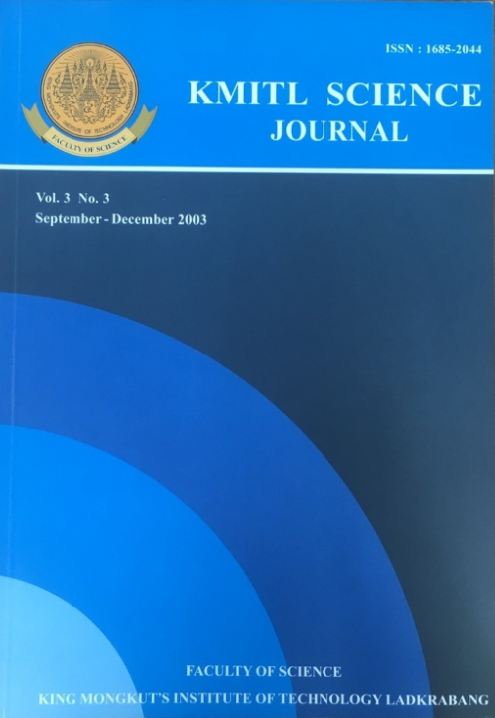Physico-Chemical Properties of Cassava Starches in Thailand
Main Article Content
Abstract
Casava starches prepared from 7 recommend (Thai Ministry of Agriculture and Cooperative) varieties of cassava roots Rayong 1, Rayong 3, Rayong 5, Rayong 60, Rayong 90, Kasetsart 50 and Sriracha 1 were studied in detail. The chemical properties were moisture content (7.02-9.12%), phosphorus content (0.014-0.017%), lipid content (0.019-0.104%), crude protein content (0.097-0.190%) and amylose content (12.66-16.74%). The physical properties were; granular size (average 12.64-15.67 µm) granular shape (magnification x 1000), percent transmittance (%T) (80.06 – 83.50), X-ray diffraction pattern (scanning region 4° - 60° of 2θ), gelatinization temperature (60.45-69.75°C), maximum viscosity of starch paste (315-495 B.U.), and thermal properties (To = 63.97-68.05 °C, Tp= 70.60-73.90 °C, Tc= 81.20-84.40 °C, ΔH = (-436.37) – (-660.37) cal/mol. In addition, 2 brands of commercial cassava starches were analyzed to compare with the recommended-variety cassava starches. Some differences properties were found between the two groups of cassava starches.
Keywords: Cassava starches, recommended-variety cassava starches, commercial cassava starches
Corresponding author: E-mail: kkarunee@kmitl.ac.th
Article Details
Copyright Transfer Statement
The copyright of this article is transferred to Current Applied Science and Technology journal with effect if and when the article is accepted for publication. The copyright transfer covers the exclusive right to reproduce and distribute the article, including reprints, translations, photographic reproductions, electronic form (offline, online) or any other reproductions of similar nature.
The author warrants that this contribution is original and that he/she has full power to make this grant. The author signs for and accepts responsibility for releasing this material on behalf of any and all co-authors.
Here is the link for download: Copyright transfer form.pdf
References
[2] The Thai Cassava Flour Industries Trade Association, 18th Anniversary the Thai Cassava Flour Industries Trade Associations, 1994.
[3] Rayong Field Crops Research Center, Field Crops Research Institute, Department of Agricultural, Ministry of Agriculture and Cooperatives, Report of Cassava Starch, September, 1994.
[4] J.A. Radley, Starch Production Technology, Applied Science: London, 1970, 135-201.
[5] AOAC Official Methods of Analysis. 13th ed., Association of Official Analytical Chemists, Washington, D.C. 1980.
[6] L.W. Aurand, A.E. Woods and M.R. Wells, Food Composition and Analysis, Van Nostrand Reinhold: USA, 1987, 29-30.
[7] L.Z. Wang and P.J. White, “Structure and Physico-Chemical Properties of Starches from Oats with Different Lipid Contents”, Cereal Chem. 71(5), 1994, 443-450.
[8] C. Balagopalan, and others. Cassava in Food, Feed, and Industry, CRC: Boca Raton, 1988, 113-190.
[9] J.L. Jane, L. Shen and F. Agiular, “Characterization of Pejibaye Starch”, Cereal Chem. 69(1), 1992, 96-100.
[10] M. Wooton and D. Madhar, “Properties of Starches from Australian Part 2: Some Physico-Chemical Properties”, Starch/Stärch, 45, 1991, 295-299.
[11] Asaoka, M. and Rickard, J.E. “Season Effects on the Physico-Chemical Properties of Starch from Four Cultivars of Cassava.”, Starch/Stärch, 43(12), 1991, 455-459.


